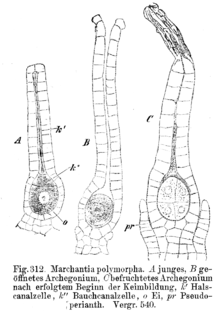Archegonium

The archegonium is the female reproductive organ ( gametangium ) of the land plants ( mosses , vascular spore plants and naked-seed plants ) in which the egg cell is formed. The male counterpart is the antheridium .
construction
The archegonia stand on the surface of the gametophyte or are sunk into it. In the typical form of the mosses and vascular pore plants (which are collectively referred to as archegonies), the archegonium consists of a thickened belly part, in which the egg cell sits, and a slender neck part. The wall of the stomach and neck usually consists of a layer of cells. Inside the abdomen there is a large cell that divides into the egg cell and the smaller abdominal canal cell. One or more cervical canal cells connect to the top. Abdominal and cervical canal cells become mucous and allow the male gametes to penetrate.
In the Nacktsamern the archegonia are reduced, but still recognizable as such.
The female gametophytes are so greatly reduced in the Bedecktsamern that no archegonium is formed any more. "It is possible that the synergids are homologous to the neck wall cells of archegonia ."
supporting documents
- Peter Sitte , Elmar Weiler , Joachim W. Kadereit , Andreas Bresinsky , Christian Körner : Textbook of botany for universities . Founded by Eduard Strasburger . 35th edition. Spektrum Akademischer Verlag, Heidelberg 2002, ISBN 3-8274-1010-X .
- Gerhard Wagenitz : Dictionary of botany. The terms in their historical context . 2nd expanded edition. Spektrum Akademischer Verlag, Heidelberg / Berlin 2003, ISBN 3-8274-1398-2 (keyword Archegonium ).
Individual evidence
- ^ Peter Sitte , Elmar Weiler , Joachim W. Kadereit , Andreas Bresinsky , Christian Körner : Textbook of botany for universities . Founded by Eduard Strasburger . 35th edition. Spektrum Akademischer Verlag, Heidelberg 2002, ISBN 3-8274-1010-X , p. 767 .